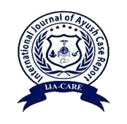Rubber Band Ligation as Effective Treatment Modality in Second Degree Haemorrhoids
Abstract
In the present modern age, the majority of people are suffering from haemorrhoids. Mithyaahara- Vihara (faulty food habits and improper sedentary lifestyle) has increased its incidence. Haemorrhoidectomy either open or closed is an invasive procedure for the treatment of hemorrhoids. A noninvasive measure for the treatment of second degree haemorrhoids is Rubber Band Ligation. In this procedure hemorrhoids are tied off at its base with rubber bands to cutting off blood flow resulting in necrosis of the haemorrhoidal stump. It relies on the principle of mucosal fixation. In the present clinical study Rubber Band, Ligation was done in randomly selected 15 patients of either sex with Second degree haemorrhoids. The duration of the trial was of 15 days, with a follow-up of 4 weeks. The total effect of therapy was assessed based on Clinical and Postoperative criteria. The significance of the treatment was determined by Statistical analysis. The significance level was p<0.05 for all values. Rubber Band Ligation has the advantages of no requirement of anesthesia, minimal hospitalization, and less postoperative pain. Hence after clinical study, it can be concluded that Rubber Band Ligation is a timely accepted effective modality to treat symptomatic second degree haemorrhoids. Through a non-invasive approach, it cures second degree haemorrhoids without disturbing normal haemorrhoidal cushion.

